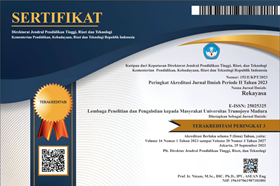Penapisan antibakteri pada Bakteri Simbion Sinularia sp terhadap Escherichia coli
Abstract
karang lunak) memiliki metabolit sekunder dengan konsentrasi yang rendah (10-6% dari berat basa invertebrata). Oleh karena itu dibutuhkan cara yang lebih konservatif dalam pemanfaatan metabolit sekunder untuk menjaga keseimbangan ekosistem.Tujuan dari penelitian ini adalah mengisolasi bakterisimbion Sinularia sp dan melakukan penapisan aktivitas antibakteri terhadap Escherichia coli. Isolasi bakteri simbion Sinularia sp dilakukan dengan menggunakan metode pengenceran dan sebar (spread). Purifikasi bakteri menggunakan metode streak, kemudian, uji antibakteri dilakukan dengan menggunakan metode overlay dan difusi agar. Sebanyak 5 isolat bakteri didapatkan dari hasil isoasi sampel. Hasil uji aktivitas antibakteri menunjukkan sebanyak 4 isolat (Isolat L2.2, L2.3, L2.4, dan L2.5) memiliki aktivitas antibakteri terhadap bakteri Escherichia coli. Isolat L2.5 memiliki diameter zona hambat terbesar yaitu sebesar 2,207 ± 0,401 cm.
Kata Kunci: Sinularia sp, Antibakteri, Escherichia coli, Gili Labak.
Skrinning Antibacterial from Sinularia sp Symbiont Bacteria Againts Escherichia coli
ABSTRACT
Several studies have shown that invertebrates (including soft corals) contain secondary metabolites in low concentration (10-6% by wet weight of invertebrate). Therefore a more conservative approach is needed in the utilization of secondary metabolites to maintain the balance of ecosystems. The purposes of this study was to isolate the bacterium Sinularia sp and to screen antibacterial activity against Escherichia coli. Isolation of the bacteria symbione of Sinularia sp was performed by dilution method and spread. Purification of bacteria was performed by streak metho then, antibacterial test was done by using overlay method and agar disk-diffusion. A total of 5 bacterial isolates were obtained from the result of the isoation of the sample. The result of antibacterial activity test showed 4 isolates (Isolates L2.2, L2.3, L2.4, and L2.5) had antibacterial activity against Escherichia coli. Isolates L2.5 has the largest inhibitory zone diameter of 2.207 ± 0.401 cm.
Keywords: Sinularia sp, Antibactery, Escherichia coli, Gili Labak.
Keywords
Full Text:
PDFReferences
Barrios-Gonzalez.2003. Microbial Secondary Metabolites Production and Strain Improvement. Indian Journal of Biotechnology, 2:322-333
Benson H J. 2002. Microbiological Applications A Laboratory Manual in General Microbiology 8th Edition. New York: The McGraw-Hill Companies
Faulkner, D. J., M.K. Harper, M.G. Haygood, C.F. Salomon, E.W. Schmidt. 2000. Symbiotic Bacteria in Sponge: Source of Bioactive Substance. In: Fusetani, N. (Ed). Drugs from the Sea, 107-119.
Iqbal, J. R. Siddiqui, N. A. Khan. 2014. Acanthamoeba and Bacteria Produce Antimicrobials to Target Their Counterpart. Parasites & Vector, 7:56.
Lay, B. W. 1994. Analisis Mikroba di Laboratorium. PT RajaGrafindo Persada, Jakarta.155 hlm.
Proksch, P., R.A. Edrada, and R Ebel. 2002. Drugs from the Seas Current Status and Microbiological Implications. Appl. Microbiol. Biotechnol. 59: 125-134.
Radjasa O. K, A. Sabdono, Junaidi and E. Zocchi. Richness of secondary metabolite-producing marine bacteria associated with Sponge Haliclona sp.. Int. J. Pharmacol. 2007.3(3):275-9.
Sabdono, A & Radjasa, O. K. 2006. Anti-Bacterial Property of A Coral-Associated Bacterium Bacillus sp Against coral Pathogenic BBD (Black Band Disease). Journal of Coastal Development, 9:175-182.
Sammarco, P.W. and J. C. Coll 1990. Lack of predictability in terpenoid function: Multiple roles and integration with related adaption in soft corals. J. Chem. Ecol. (16) 1: 273-289.
Teasdale, M. E., J. Liu, J. Wallace, F. Akhlaghi, D. C. Rowley. 2009. Secondary Metabolites Produced by the Marine Bacterium Halobacillus salinus That Inhibit Quorum Sensing-Controlled Phenotypes in Gram-Negative Bacteria. Appl. Environ. Microbiol., 75 (3): 567–572.
Waluyo, L. 2012. Mikrobiologi Umum. UMM Press, Malang, 344.
DOI
https://doi.org/10.21107/rekayasa.v10i2.3609Metrics
Refbacks
- There are currently no refbacks.
Copyright (c) 2018 Ary Giri Dwi Kartika

This work is licensed under a Creative Commons Attribution-ShareAlike 4.0 International License.
























